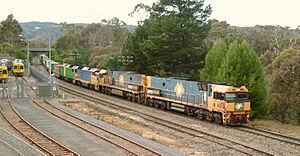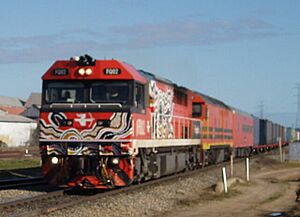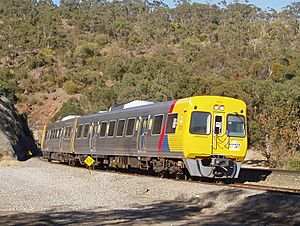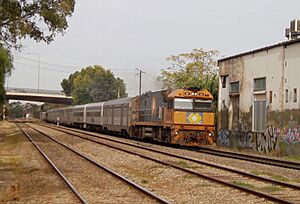Rail transport in South Australia facts for kids
South Australia has a long and interesting history with railways. The very first railway line in the state opened in December 1853. It connected the port town of Goolwa on the River Murray to a harbor at Port Elliot. This helped move goods between riverboats and ocean ships.
Over the years, more railway tracks were built across South Australia. This often happened to help farms grow or to create jobs. By 1966, the state had about 3,991 kilometers (2,480 miles) of railway lines. These lines used two different widths, called gauges: 2,657 kilometers (1,651 miles) were 1,600 mm (5 ft 3 in) (broad gauge), and 1,334 kilometers (829 miles) were 1,067 mm (3 ft 6 in) (narrow gauge).
Today, many of the old regional lines are closed. South Australia's railway network now mainly includes 1,435 mm (4 ft 8 1⁄2 in) standard gauge lines that connect to other states. There are also 1,600 mm (5 ft 3 in) broad gauge suburban trains in Adelaide. A special narrow-gauge line on the Eyre Peninsula carries gypsum, and standard-gauge lines north of Tarcoola carry copper-gold and coal.
Contents
- How Railways Started in South Australia
- Understanding Rail Gauges
- Who Runs the Trains Today?
- Passenger Train Journeys
- Preserving Railway History
- Key Moments in South Australian Railway History
- How the Lines Grew Across South Australia
How Railways Started in South Australia
The very first railway in South Australia was a horse-drawn tramway. It opened in 1854 and ran from Goolwa to Port Elliot. This line helped move goods between boats on the Murray River and ships in the ocean. It meant ships didn't have to go through the tricky mouth of the river. Later, this line was extended to a safer harbor at Victor Harbor.
The first railway in Adelaide itself was built in 1856. It connected the city to its port. All the early Adelaide railways used a wide track width, known as broad gauge (1,600 mm (5 ft 3 in)). Slowly, a network of lines grew out from Adelaide. These lines were first used to carry ore, especially copper. Later, they carried goods from the Murray River and grain from large farms. In the first half of the 1900s, most of these lines also carried passengers.
The main railway line connecting Adelaide to Melbourne opened in 1886. This happened after a bridge was built at Murray Bridge. It was special because it was the first railway between two state capitals that didn't need passengers or goods to change trains due to different track widths. However, it was the last of these lines to be changed to standard gauge in 1995.
Understanding Rail Gauges
Rail gauge is the distance between the two rails on a railway track. In 1847, South Australia was the first Australian colony to decide to use the "standard gauge" of 1,435 mm (4 ft 8 1⁄2 in). This is the most common track width used around the world.
However, things got complicated! In 1848, the British government suggested all Australian colonies use standard gauge. But the company building the first railway in New South Wales chose a wider "Irish" broad gauge (1,600 mm (5 ft 3 in)). Soon after, Victoria and South Australia ordered their trains to fit this wider gauge. New South Wales then changed its mind back to standard gauge, but it was too late for Victoria and South Australia to change again. This mix-up led to Australia's "mixed gauge muddle," which still causes some issues today.
The main railway line from Adelaide to Melbourne was opened in 1886. It was the first line between Australian capital cities that didn't have a break-of-gauge (where the track width changes). But it took 109 years, until 1995, for this line to be converted to standard gauge. It was the last major inter-capital line to be changed.
What is Narrow Gauge?
Some parts of South Australia also used "narrow gauge" railways, which are 3 ft 6 in (1,067 mm) wide. This was often done to save money, as these lines were cheaper to build. Queensland Railways had successfully used narrow gauge since 1865, which influenced South Australia.
Many narrow-gauge lines started as separate tracks from different ports like Port Wakefield, Port Pirie, and Port Lincoln. At first, the problem of different track widths wasn't obvious. But when the broad and narrow systems finally met at places like Hamley Bridge and Terowie, it caused many complaints because goods and passengers had to switch trains.
The main railway lines connecting Adelaide to other major cities like Perth, Darwin, Melbourne, and Sydney are all now standard gauge.
Who Runs the Trains Today?
In the past, most country railways were owned by South Australian Railways. Later, some lines were taken over by Commonwealth Railways, which eventually merged with South Australian Railways to form Australian National Railways Commission (ANR) in 1978.
Today, the trains in Adelaide's city area are owned and run by Adelaide Metro. Long-distance passenger trains that travel between states are operated by Journey Beyond. Freight trains within South Australia are run by One Rail Australia, while interstate freight is handled by several companies, including Bowmans Rail, One Rail Australia, Pacific National, and SCT Logistics.
Passenger Train Journeys
There are fewer passenger train services in South Australia now compared to the past. Today, you can ride the Adelaide Metro trains for local trips around the city. For longer journeys, Journey Beyond operates several famous trains:
- The The Overland travels between Adelaide and Melbourne.
- The Indian Pacific goes from Perth to Sydney, stopping in Adelaide.
- The Great Southern runs between Adelaide and Brisbane.
- The Ghan travels from Adelaide all the way to Darwin, passing through Alice Springs.
Since 1990, there have been no regular passenger train services to country towns within South Australia.
Preserving Railway History
South Australia has some great places where you can learn about railway history:
- The National Railway Museum in Port Adelaide is the largest indoor railway museum in Australia.
- The SteamRanger Heritage Railway in the Adelaide Hills has restored old steam and diesel trains. They offer fun tourist rides between Mount Barker and Victor Harbor.
- The Pichi Richi Railway Preservation Society in Quorn operates on a part of the old Central Australia Railway.
- The Steamtown Heritage Rail Centre in Peterborough is a museum located in old railway workshops.
Key Moments in South Australian Railway History
- 1854: The first horse-drawn tramway opened from Goolwa to Port Elliot.
- 1856: The first broad gauge (5 ft 3 in (1,600 mm)) line opened from Adelaide to Port Adelaide.
- 1869: The first narrow gauge (3 ft 6 in (1,067 mm)) line opened from Port Wakefield to Hoyleton.
- 1878: The first "break of gauge" happened at Hamley Bridge, where broad and narrow gauge lines met.
- 1886: The main line to Melbourne opened after the bridge at Murray Bridge was built.
- 1888: A narrow gauge line from Port Pirie to Broken Hill, New South Wales, was completed.
- 1917: The first standard gauge line, the Trans-Australian Railway, was completed between Port Augusta and Kalgoorlie, Western Australia.
- 1929: The Great Northern Line was extended to Alice Springs and renamed the Central Australia Railway.
- 1957: A new standard gauge line was built from Stirling North to Marree, replacing the old narrow gauge line.
- 1970: The Port Pirie to Broken Hill line was converted to standard gauge, completing the standard gauge link from Sydney to Perth.
- 1980: The standard gauge railway from Tarcoola to Alice Springs opened.
- 1982: The Adelaide to Crystal Brook standard gauge railway opened, connecting Adelaide to the national standard gauge network.
- 1995: The Adelaide to Melbourne line was changed from broad gauge to standard gauge.
- 2003: The standard gauge Adelaide to Darwin Railway was finally completed.
- 2014: The Noarlunga Centre line was extended to Seaford, and electric trains started running on the Seaford and Tonsley lines.
- 2022: The Gawler railway line was electrified.
The first steam-operated railway line in South Australia was built in 1856. It was a broad gauge (5 ft 3 in (1,600 mm)) line connecting Adelaide to Port Adelaide. This line is now part of the Adelaide suburban network. It was extended to Outer Harbor in 1908.
How the Lines Grew Across South Australia
Southern Lines: Connecting to Victoria and the Coast
The South Line, which goes through the Adelaide Hills, opened in stages. It reached Murray Bridge in 1884 and connected with Victorian railways at Serviceton, Victoria, in 1887. This line was changed to standard gauge in 1995.
A branch line was built to Marino in 1913 and extended to Willunga in 1915. Part of this line closed in 1969. In the 1970s, the line was extended south from Hallett Cove and is now the Adelaide Metro Seaford railway line.
The Victor Harbor railway line started as a horse-drawn tramway in 1854. It connected Goolwa on the Murray River to Port Elliot. This line helped move goods between riverboats and ocean ships. It was later extended to Victor Harbor and then to Mount Barker Junction on the South Line in 1884.
In the Murray Mallee region, the Pinnaroo line was built from Tailem Bend to Pinnaroo in 1906. This line connected with the Victorian railways. The South Australian part of this line was changed to standard gauge in 1998. The last time this line carried grain was in 2015, after which all grain transport switched to roads.
Other lines in the Murray Mallee, like the Barmera railway line, opened in 1913. These lines helped open up land for farming wheat. They were built using recycled rails and were the first in the state to use steel sleepers. Many of these lines, like the Loxton railway line, also closed to rail traffic after 2015.
Southern Narrow Gauge Lines
In 1876, a narrow gauge (3 ft 6 in (1,067 mm)) line called the Kingston-Naracoorte railway line was built from Kingston SE to Naracoorte. Another line was built between Beachport, Millicent and Mount Gambier in 1879. These lines were later connected, creating a "break-of-gauge" at Wolseley where the track width changed.
From 1953 to 1956, most of these southeastern lines were changed to broad gauge. However, some sections were closed instead. Many of these lines have been out of use since the main Adelaide-Melbourne line was changed to standard gauge in 1995.
Northern Lines: Expanding Northward
Broad Gauge Lines in the North
In 1857, the Gawler railway line was built to Gawler and later extended to Kapunda in 1860. The main line then went to Burra in 1870 and further to Terowie in 1880.
The Barossa Valley railway line was built in 1911, connecting Gawler to places like Angaston in the Barossa Valley. The Penrice Stone Train, which carried limestone from a quarry at Penrice, was the last train to operate on this line until 2014.
A line from Riverton to Clare and Spalding was built in 1919. This line was later removed, and parts of it are now used as walking and cycling trails like the Rattler Trail and Riesling Trail.
In 1925, a broad gauge line was built from Salisbury to Redhill, and extended to Port Pirie in 1937. This line was changed to standard gauge in 1982.
Western Narrow Gauge Lines
The lines in the Mid North region, generally north of Goyder's Line (an imaginary line showing where farming is possible based on rainfall), were built using narrow gauge (1,067 mm (3 ft 6 in)).
The first narrow gauge line in this area ran from Port Wakefield to Hoyleton, opening in 1870. It later branched to Hamley Bridge, creating Australia's first "break-of-gauge" on government railways.
A horse-drawn tramway was built between Wallaroo and Kadina in 1862. This line was later taken over by the state railways and converted to narrow gauge. These lines were changed to broad gauge in 1927. Many of these lines were closed after the Adelaide–Crystal Brook standard gauge line opened in 1982.
The Great Northern Railway: Into the Outback
The Great Northern Railway was completed from Port Augusta to Quorn in 1879. It then extended to Marree in 1883 and Oodnadatta in 1891. This line was extended to Alice Springs by the Commonwealth Railways in 1929 and renamed the Central Australia Railway.
In 1957, a new standard gauge line was built from Stirling North (near Port Augusta) to Marree. The old narrow gauge line was abandoned in parts. The narrow gauge line from Marree to Alice Springs was closed when the new standard gauge railway from Tarcoola to Alice Springs opened in 1980.
Eyre Peninsula Lines: Isolated but Important
The railway lines on the Eyre Peninsula were built as narrow gauge (1,067 mm (3 ft 6 in)). They were built lightly because their main purpose was to help farms grow in the area. Construction started in 1907 with a line between Port Lincoln and Cummins. By 1950, the network was 767 kilometers (477 miles) long.
These lines were very important in the early days because there were few good roads. Communities relied on the railway to transport their farm products to port, bring in supplies, and carry passengers. As roads improved, passenger services stopped in 1968. The system mostly closed in 2019 when grain transport switched to roads. As of 2023, only a 65-kilometer (40-mile) section remains operational, carrying gypsum.
The steel company BHP also built two separate railway systems on the peninsula. The BHP Whyalla Tramway, a 112-kilometer (70-mile) narrow gauge line, opened in 1901 and still carries iron ore today. The Coffin Bay Tramway, a standard gauge line, carried mineral sand from 1966 to 1989.
Northern Territory Railway: Connecting North
The Northern Territory was part of South Australia from 1863 to 1911. During this time, the Palmerston and Pine Creek Railway was built. This narrow gauge (1,067 mm (3 ft 6 in)) railway ran from Darwin (then called Palmerston) to Pine Creek. It was completed in 1888, with thousands of Chinese laborers helping to lay the tracks quickly.
The Commonwealth Government took over the line in 1911 and extended it further north. Although a railway line from Alice Springs to Darwin had been planned for many years, the northern line closed in 1976. However, the standard gauge Adelaide to Darwin Railway was finally completed on September 17, 2003, connecting Alice Springs to Darwin. The first freight train reached Darwin in January 2004.
Adelaide's City Train Network
Adelaide's metropolitan rail network was the last of Australia's five major cities to get electric trains. A lot of money was put into electrifying and changing the track width of some lines.
However, not all lines have been electrified yet. For example, the Belair railway line is not planned to be electrified at this time.






